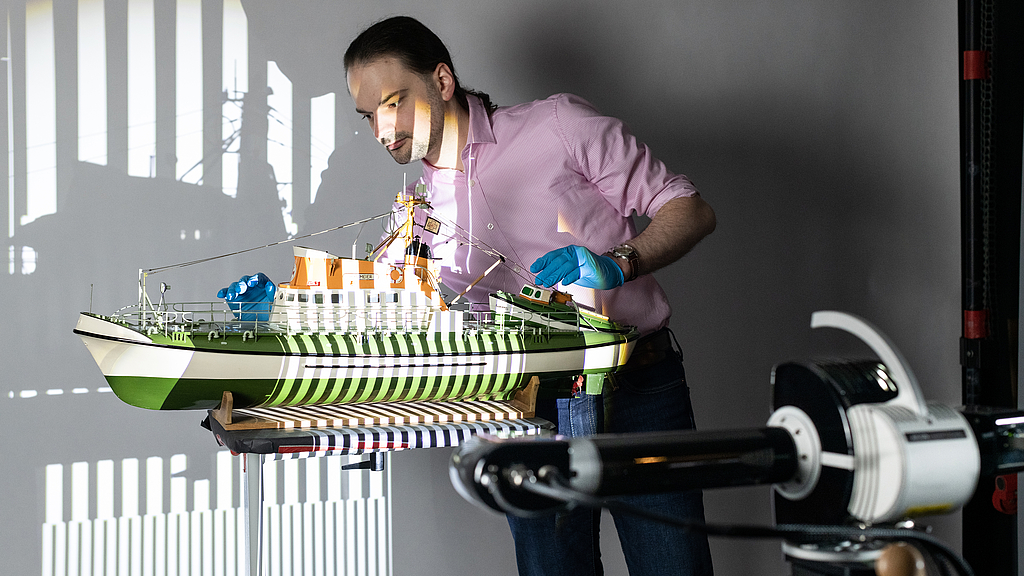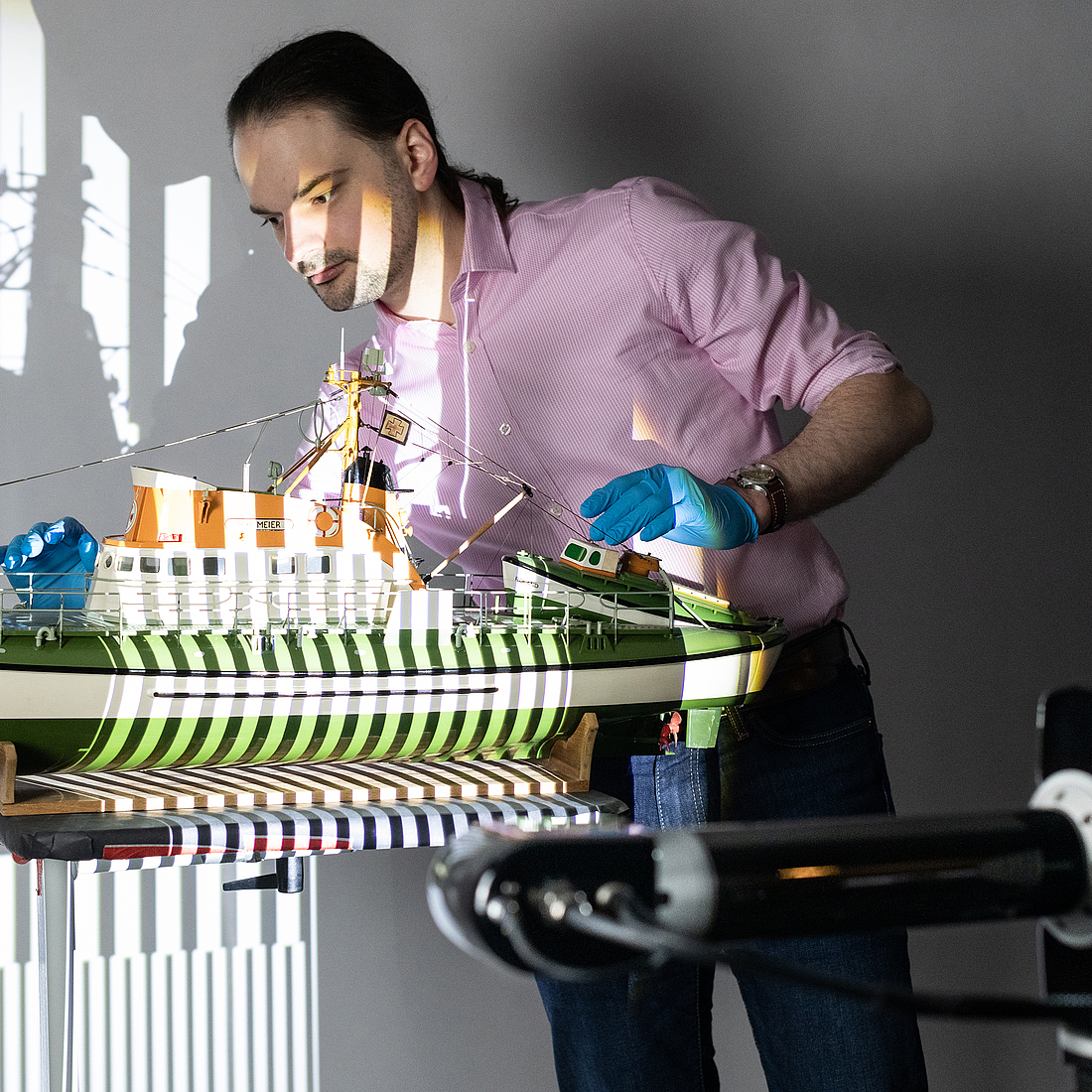Pioneers in museum digitization
With it´s digitization team, the German Maritime Museum / Leibniz Institute for Maritime History is looking for answers to questions that many museums are asking themselves: How can the interaction between historical objects and digital offerings best succeed? What tools will the museum of the future need? The methods that will be developed at the German Maritime Museum in the coming years will not only be used there in the future, but will also help other museums to create attractive digital offerings.
The German Maritime Museum in 2026 - what will museum visits look like in the future? Dr. Dennis Niewerth, head of the team for science-led digitization at the German Maritime Museum, sees guests in their mind's eye taking a model of a ship with their smartphone, scanning it via an app and getting up close to the object to track down hidden facts, and even printing a 3D model as a memento. Experts and laymen alike browse globally accessible databases at the click of a mouse and inspect the virtual twins of figureheads, photographs or ship bells currently slumbering in the depot for lack of space from their home screens. In short, the guests develop treasure hunter qualities and conduct independent research on various questions relating to an exhibit.
Digitization makes it possible to uncover and experience hidden treasures and get closer to them than was previously possible by looking through a display case. Dr. Dennis Niewerth and his new department are paving the way for these ideas. At the Joint Science Conference, the German Maritime Museum successfully applied for the necessary funding: the federal and state governments will provide 1.25 million euros over the next three years as a first step. As a so-called "special item of expenditure," the money adds to the German Maritime Museum budget for a specific purpose and firmly anchors the digitization strategy in the infrastructure. This means that it is now just as much a part of the house as, for example, collection management, restoration or accounting.
Six positions were created at the house, and a professorship at the University of Oldenburg has been advertised. "The special status is a great success for the DSM. As a result, we are rising to become a big player in the field of digitization throughout Germany," says Niewerth. The media scientist's vision: the German Maritime Museums virtual path should set a precedent in other exhibition houses as the "Bremerhaven Method." "We work with free software wherever possible - and keep our in-house developments user-friendly and low-threshold. Especially in the area of 3D capture and visualization, we are creating solutions that would be applicable far beyond Bremerhaven." But before the method leaves the confines of the German Maritime Museum, the team faces the mammoth task of photographing numerous objects from its own collection, capturing them and making them tangible. With the help of various scanning techniques, 3D models are created, for example. Various ship half-models of the Junge Werft are already available to the public. At present, the priority is to capture the inventory of the Norddeutscher Lloyd shipping company with tableware, ship models and voyage equipment. In the future, the digital experts will work with the curators to develop suitable virtual counterparts to the analog exhibitions. Digital curator Isabella Hodgson will act as an interpreter, finding the complementary virtual counterpart for analog exhibition formats.
Digitization opens doors online and shares knowledge. Open Data is the boundless goal - researchers and interested parties should be able to find cultural treasures easily and without barriers via globally accessible databases and explore and use them individually. The digital object is a perfect complement to the analog one. In complete contrast to the philosopher Walter Benjamin, who assumed that technical reproducibility would destroy the aura of a work of art, Niewerth sees great added value in it: "We let the exhibits off the leash, so to speak, and extend them." Freed from showcases and depots, they then tell many stories and no longer just one that just fits the reference of the current exhibition. The exciting new methods invite visitors to come to the museum and experience the museum of the future in a whole new way.
Employees of the digitisation team and their focus areas
Dr. Alexander Reis - Research Associate for Digital Documentation
My role in the digitization team is ...
to be found in many areas of work. For example, I am responsible for analyzing and optimizing data storage in the collection database, as well as research data from projects at the Maritime Museum. Making the museum's collection holdings visible and interconnected is the most public-facing area.
How diverse will museum visits be in the future?
In the future, the museum visit will begin for many at home on the museum website on the Internet. As a nice prelude to the actual visit, visitors will be able to zoom in on valuable items such as ship models, even in 3D, down to the smallest detail, and immerse themselves in collections in the depot that are clearly arranged by subject with just a few clicks.
In the museum itself, many more digital offerings will be created to impart knowledge to a wide variety of visitor groups. For each exhibit, there will be different topics to discover digitally in a variety of ways. The view of the originals will thus be sharpened even further and the originals will be given even more of an aura.
Luca Junge - Employee 3D Capture and Imaging
My task in the digitalization team is ...
... the development and programming of interactive web applications for the visitors of the museum. Both for use on smartphones and tablets during the museum visit and at home on the laptop or PC.
Your most exciting task so far has been ...
Getting familiar with the technologies and devices we use to create and interact with the 3D models. This makes me constantly discover new angles on how to better integrate the 3D content into the museum context and subject areas.
Helena Grebe - Photographic Service / Digital Image Acquisition
My task in the digitization team is ...
the photographic documentation of objects in the context of collection, research and exhibition. I also create scans of two-dimensional materials.
What opportunities does digitization hold for museums?
Digitization can reach a much larger audience - especially people who would otherwise not or rarely come to our museum. Age, income and geographic location no longer play as big a role as they do with physical museum visits. The visit is not replaced by the digital offer, but offers a contemporary extension to the existing museum offer.
Dennis Hoffmann - 3D Capture and Imaging Staff Member
My job in the digitization team is ...
My job in the Digitization team is primarily to create 3D digitized images and prepare them for display on the web. As an interaction designer, I also help to develop design and operating concepts for interactive applications such as webAR.
What are the advantages of 3D models?
To understand the essence of an object, it must be viewed from many perspectives. In the context of museum objects, 3D models not only offer the possibility of representing their spatiality, but also open up completely new ways of viewing them. Thus, 3D as a medium represents a valuable addition in the field of education and the communication of knowledge.
Dr. Isabella Hodgson - Digital Curator
My task in the digitalization team ...
is to develop my own digital education concepts and to advise colleagues on the implementation of virtual offerings. In addition, I develop guidelines on important digital topics. I also try to contribute to improving the technical infrastructure.
Is digital the more exciting analog?
The laws of virtual space are very different from those of a physical exhibition setting. That's precisely why online formats are an ideal complement to our analog offerings.
Karolin Leitermann - Scientific Coordinator of the
SAW project "Digital Materialities
My task in the Digitization Team is ...
My task in the Digitization Team is to act at the interface of analog and virtual exhibition.
Which project are you currently working on?
I am currently working as a scientific coordinator in the SAW project "Digital Materialities".

Dr. Dennis Niewerth prepares a ship model for the strip light scanner.
Photo: DSM / Helena Grebe

